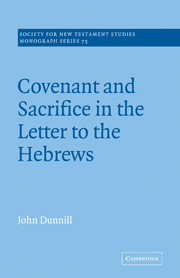Book contents
- Frontmatter
- Contents
- Preface
- List of abbreviations
- A NOTE ON TRANSLATIONS
- Introduction: Hebrews and historical criticism
- Part I Sociology
- Part II Structuralism
- 2 Hebrews and structural analysis
- 3 Sacrifice and covenant in the Old Testament
- Part III Renewing the covenant
- Conclusion
- Bibliography
- Index of passages quoted
- Index of modern authors
- Subject index
2 - Hebrews and structural analysis
Published online by Cambridge University Press: 07 January 2010
- Frontmatter
- Contents
- Preface
- List of abbreviations
- A NOTE ON TRANSLATIONS
- Introduction: Hebrews and historical criticism
- Part I Sociology
- Part II Structuralism
- 2 Hebrews and structural analysis
- 3 Sacrifice and covenant in the Old Testament
- Part III Renewing the covenant
- Conclusion
- Bibliography
- Index of passages quoted
- Index of modern authors
- Subject index
Summary
Contexts and meanings
Chapter 1 has offered, as an alternative to historical criticism, one way of reading Hebrews which seeks to be holistic and intratextual, via the community presented in the text. In this chapter it will be argued that the sacrificial symbolism of the book cries even more stridently for an holistic approach, such as can be provided by anthropological studies of religion. To do so, it is necessary to enter into the debate about contexts of interpretation. Contextual issues reach far down into the interpretative process, from exegetical questions about cultural, historical and philosophical ‘background’ to methodological discussions about the disjunction between the ‘horizons’ of ancient texts and their modern readers, and whether it is necessary, or possible, for these horizons to become ‘fused’.
One recent provocative proposal about contexts in Biblical criticism is that of Brevard Childs. Since he also reaches the conclusion that historical criticism, however excellent, has not materially assisted the reading of Hebrews, it will be helpful at the outset to show why ‘canonical criticism’, though likewise holistic, integrative and hermeneutical in form, is not the solution towards which this argument is tending.
- Type
- Chapter
- Information
- Covenant and Sacrifice in the Letter to the Hebrews , pp. 43 - 63Publisher: Cambridge University PressPrint publication year: 1993

